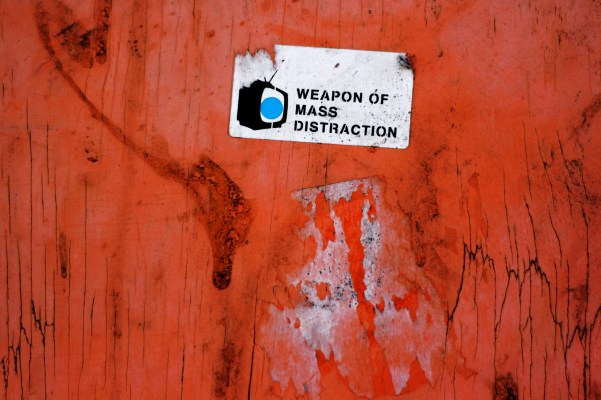BING the head of Sony Pictures is talking about CLICK my friend just uploaded a photo to Face BING the wreckage of the AirAsia flight PLOP Danny, are you around for dinner? We are thinking DING Try out the new version of our app CLICK the weather today will be PING Danny, we have a brilliant idea for a startup and we are launching on Kickstarter.
BUZZ. Game over.
The first minutes after waking up are regularly the most stressful of the day, and it shouldn’t be like this. I wake up to dozens of notifications on my phone, driven by an expansive array of messaging and email apps as well as news and personal updates.
Every few months, I go through a process of cracking down on all of these sources, from retooling my settings in Notification Center to changing my email preferences on websites and apps. Yet no matter how many times I attempt to ameliorate the situation, it always seems to revert back to an unsustainable level. Worse, if I just try to ignore it all, friends, colleagues, and sources complain that I am out-of-touch since I haven’t responded to their entreaties in some arbitrarily short timeframe.
Increasingly, we are merging with our devices to become a part of them, blurring the line of who is responding to who. It used to be that I could sit and read a book for hours without even worrying about the time. Now, I can barely go more than a couple of pages without pulling my phone out of my pocket to make sure something hasn’t happened.
I know I am not the only one who is recognizing this change – it’s common fodder for dinner conversations. Yet almost everyone I talk to has already thrown in the device on the issue (so to speak), surrendering to our devices without even putting up a fight.
This is the year I stop.
Researchers investigating distractions have unequivocally shown that multitasking and interrupting our thoughts has an enormous deleterious effect on our performance. Overall productivity drops precipitously as our brain scrambles to try to keep up with the constantly changing tasks we throw at it. The real damage though isn’t just efficiency, but also the decline in deep thought and creativity that is at the core of excellent, innovative work. We all want to do our best, but what happens if the very devices we are using prevent us from doing it?
I wish personal resolve was sufficient to ensure that distractions would go away, but that simply isn’t the case. Instead, we as a society are encouraging more interactions, often with the the ridiculous hope that it will increase performance or profits.
Just take the spread of open plan workspaces, which this year was estimated to reach 70% of all offices in the United States, according to industry sources. As these offices have flourished, our productivity has done anything but, leading to a spate of articles in almost every publication about their downsides this year.
Investigators have obviously shown that performance declines in such distraction-prone environments, but that isn’t even the worse of it. These offices can also increase stress, blood pressure, sickness, and interpersonal tension. Yet, the trend only looks set to continue as managers drink the Kool-Aid of “fluid conversations” over “people behind desks actually doing work.”
Managers aren’t the only ones who want to see us distracted. Advertisers are encouraging the use of “second screens,” the use of mobile devices or tablets during television shows, often as a tool for social interaction with sites like Twitter. At first, the industry hesitated with this customer behavior, since the ads were on on the television after all. But now many see this new behavior as an opportunity to display ads throughout a show on the second screen, not just during commercial breaks.
I don’t want to be alarmist and argue that we are reaching peak human. Instead, we need to recognize the context that is distracting us, changing what we can change and advocating for what we can hopefully convince others to do.
My solutions aren’t novel, but I am going to commit to them more aggressively than I have in the past. First, I am going to seal off the first and final hours awake to be completely device-free. I am not going to respond to messages at midnight or 7am, but instead offer my mind a chance to calm down before and after the intensity of the workday.
Next, I am going to devote most of that first hour to determining exactly what work I need to accomplish today – and what I don’t need to do. Like many, I have allowed emails and messages to drive my to-do list, even though I already know what I should be doing. My days are not that unpredictable (except when a major news story breaks out, of course), and thus planning can greatly reduce stress and distractions – cutting down the length of my workday to boot.
Finally, I am developing a habit of keeping my apps closed when I am not immediately using them. My computer is more than powerful enough to reopen an app like Mail and have it downloading email within 10 seconds. I don’t need the continually streaming notifications across my desktop, nor do I need sound effects interrupting my work. Reducing proximity is the key here, and just having to click to open an app is often sufficient to avoid a 5-minute procrastination delay.
This distractions disease is afflicting all of us, degrading the work we do and hindering the kind of creative thinking that is critical for excellence. We need to protect that deep thinking, which is why I encourage all of you to make fighting distractions the new “lose weight” resolution of 2015. BEEP. If you will excuse me, a friend just posted an image of a cat, and I need to immediately respond to this.
